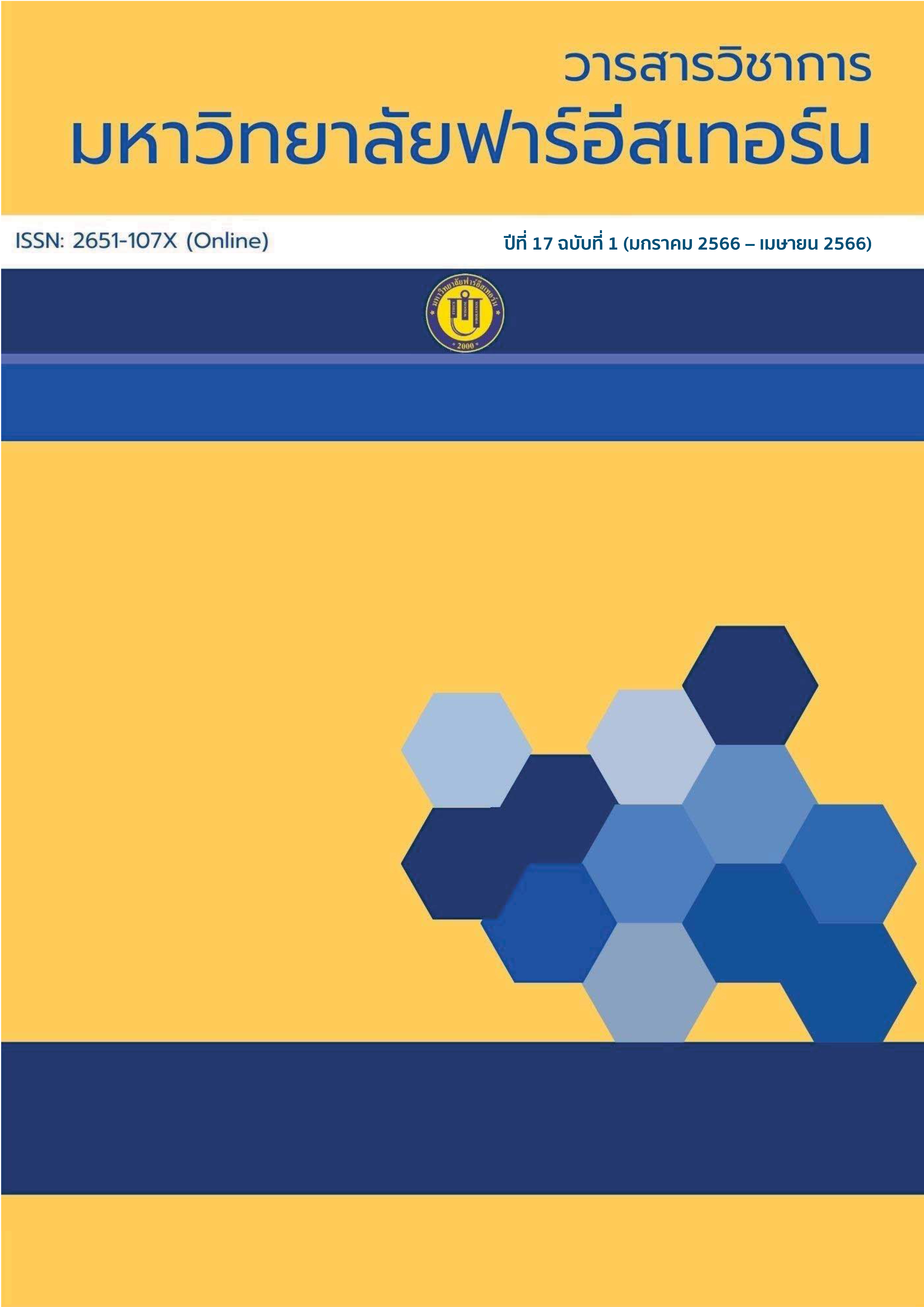The Strategies Used in Male Characters in Yaoi Novels by Bacteria
Main Article Content
Abstract
This article is a study of The Strategies Used In Male Characters In Yaoi Novels by Bacteria. It is a descriptive and analytical research. The objective was to study The Strategies Used In Male Characters In Yaoi Novels By Bacteria totaling 13 Bacteria Yaoi novels. The results showed Yaoi novels by Bacteria has strategies for creating male characters divided into 2 types Part 1. Creating a male character like a modern man is consistent with the concept of modernity or modernity showing the situation that change under the trend of liberal capitalism covering political, economic, social and cultural aspects, namely 1) personality presentation, 2) consumer presentation, and 3) space presentation. The first part of the creation of a modern masculine male character corresponds to the concept of modernity or modernity. Shows the changing situation under the trend of liberal capitalism. covering political, economic, social, and cultural aspects, namely 1) personality presentation, 2) consumer presentation, and 3) space presentation. which is consistent with the practices related to sexual desires, sexual desires, expressions in different dimensions such as desires, expressions in dress, behavior, manners, and etiquette. Has changed with the times and depended on social norms, namely 1) body presentation, 2) male-to-male relationship, and 3) sexual expression. Variety of character creation strategies corresponds to the genre of the novels and modernity.
Article Details

This work is licensed under a Creative Commons Attribution-NonCommercial-NoDerivatives 4.0 International License.
1. Any views and comments in the Journal of Social Innovation and Lifelong Learning are the authors’ views. The editorial staff have not to agree with those views and it is not considered as the editorial’s responsibility.
2. The responsibility of content and draft check of each article belongs to each author. In case, there is any lawsuit about copyright infringement. It is considered as the authors’ sole responsibility.
3. The article copyright belonging to the authors and The Far Eastern University are copyrighted legally. Republication must be received direct permission from the authors and The Far Eastern University in written form.
References
กนกพรรณ วิบูลยศริน. (2544). การเปรียบเทียบภาพตัวแทนของผู้หญิงสมัยใหม่และหลังสมัยใหม่ในภาพยนตร์ไทยและภาพยนตร์อเมริกัน. [วิทยานิพนธ์ปริญญามหาบัณฑิต, จุฬาลงกรณมหาวิทยาลัย].
คณะกรรมการการพัฒนาหนังสือแห่งชาติ ศูนย์พัฒนาหนังสือ กรมวิชาการ กระทรวงศึกษาธิการ. (2540). การประกวดหนังสือดีเด่น ประจำปีพุทธศักราช 2515-2539. กรุงเทพฯ: โรงพิมพ์การศาสนา.
ณัฏฐยา ยศสอน และ อรจิรา อัจฉริยไพบูลย์. (2563). กลวิธีสร้างภาพลักษณ์ตัวละครเหนือธรรมชาติในนวนิยายเรื่องเล่ห์บรรพกาลของวรรณวรรธน์. วารสารมังรายสาร, 8(2), 1-20. https://so04.tci-thaijo.org/index.php/mrsj/article/view/246139
นัทธนัย ประสานนาม. (2562). นวนิยายยาโออิของไทย: การศึกษาเชิงวิเคราะห์. วารสารวิชาการหอสมุดแห่งชาติ, 7(2), 16-34.
นิธิ เอียวศรีวงศ์. (2545). ว่าด้วยภาษา วัฒนธรรม และอำนาจ. กรุงเทพฯ: มติชน.
บุญเสริม หุตะแพทย์. (2545). การกำหนดบทบาทเพศและความสัมพันธ์ระหว่างชายและหญิงในประมวลสาระชุดวิชาการศึกษาบทบาทชายหญิง หน่วยที่ 1-5. นนทบุรี: มหาวิทยาลัยสุโขทัยธรรมาธิราช.
พจนานุกรม ฉบับราชบัณฑิตยสถาน. (2556). พจนานุกรมฉบับราชบัณฑิตยสถาน พ.ศ. 2542. กรุงเทพฯ: นานมีบุ๊คส์พับลิเคชั่นส์.
พรพรรณ กาญจนาธิวัฒน์. (2555). ภาพตัวแทนของผู้หญิงสมัยใหม่ในสื่อบันเทิงไทย: บทวิเคราะห์จากภาพยนตร์ เรื่อง “รถไฟฟ้ามาหานะเธอ” และละครโทรทัศน์เรื่อง “สูตรเสน่หา”. วารสารเพศวิถีศึกษา, 2, 115-140.
ราชบัณฑิตยสถาน. (2556). พจนานุกรม ฉบับราชบัณฑิตยสถาน พ.ศ. 2556. กรุงเทพฯ: ราชบัณฑิตยสถาน.
รื่นฤทัย สัจจพันธุ์. (2550). เล่าเรื่องขุนช้างขุนแผน. กรุงเทพฯ: สถาพรบุ๊คส์.
เสนาะ เจริญพร. (2546). ภาพเสนอผู้หญิงในวรรณกรรมไทยช่วงทศวรรษ 2530: วิเคราะห์ความโยงใยกับประเด็นทางสังคม [วิทยานิพนธ์ปริญญามหาบัณฑิต, มหาวิทยาลัยเชียงใหม่]. CMU Intellectual Repository. http://repository.cmu.ac.th/handle/6653943832/35460
อนุชา พิมพ์ศักดิ์ และ โสภี อุ่นทะยา. (2560). SOTUS พี่ว้ากตัวร้ายกับนายปีหนึ่ง: การประกอบสร้างอัตลักษณ์เพศนอกกรอบในนวนิยายรักวัยรุ่นแนววาย. วารสารการบริหารปกครอง, 6(2), 175-193. https://so01.tci-thaijo.org/index.php/gjournal-ksu/article/view/98243
Bacteria. (2551). เลือนตะวัน. กรุงเทพฯ: สำนักพิมพ์นาบู.
Bacteria. (2553). The Long Kiss’ Desert. กรุงเทพฯ: สำนักพิมพ์นาบู.
Bacteria. (2554). Love & Prestige. กรุงเทพฯ: สำนักพิมพ์นาบู.
Bacteria. (2555). ใจเจ้าศศิธร. กรุงเทพฯ: สำนักพิมพ์นาบู.
Bacteria. (2556). Love me if you dear. กรุงเทพฯ: สำนักพิมพ์นาบู.
Bacteria. (2559). นิทานพันดาว. กรุงเทพฯ: สำนักพิมพ์นาบู.
Bacteria. (2560). สุดทางหัวใจ. กรุงเทพฯ: สำนักพิมพ์นาบู.
Bacteria. (2563). บุพรติยา. กรุงเทพฯ: สำนักพิมพ์นาบู.

